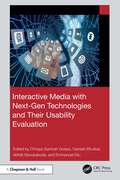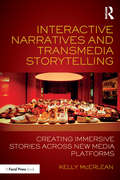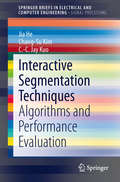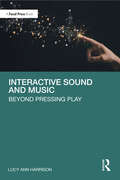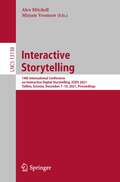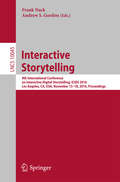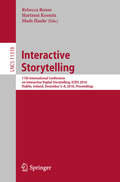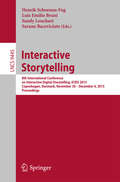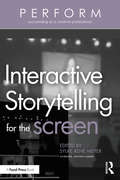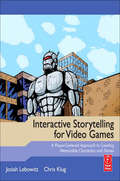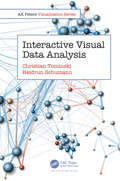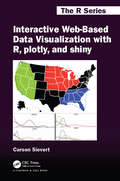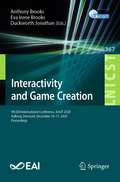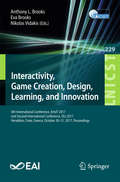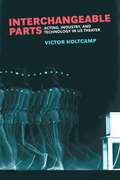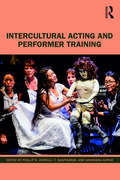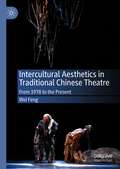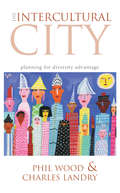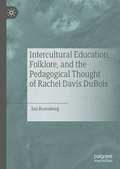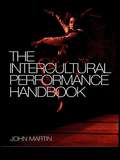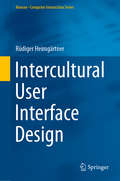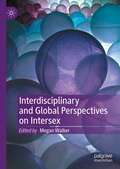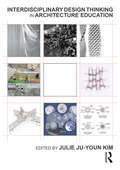- Table View
- List View
Interactive InDesign CS5: Take your Print Skills to the Web and Beyond
by Mira RubinPrint designers make the transition to multimedia by mastering the interactive capabilities of InDesign with this tutorial-based guide to the new CS5 toolset that integrates with the Adobe Flash platform.
Interactive Media with Next-Gen Technologies and Their Usability Evaluation
by Chhaya Santosh Gosavi Ganesh Bhutkar Abhijit Banubakode Emmanuel EiluInteractive media are a human-machine interface that allows people to connect with each other by making them active participants in the media they consume through text, graphics, audio and video. This book presents the challenges and opportunities presented by emerging media technologies to explore usability evaluation. It covers the current trends in interactive media technologies such as, Social Media, Dark Patterns, Internet of Things (IoT), Android Development, Assistive Technologies and Augmented Reality (AR) / Virtual Reality (VR). It explores various application areas such Education, Film and Television, Agriculture, Cyber Security, Bird Conservation, Smart Vehicles, Fashion Technology and e-Learning.Key features of this edited book are as follows:● Evaluates related Interactive Media Technologies and Applications for assessment and enhancement of their usability● Illustrates current discussions on Interactive Media Technologies such as Social Media, Dark Patterns, Internet of Things (IoT), Android Development, Assistive Technologies and Augmented Reality (AR) / Virtual Reality (VR)● Includes various case studies from application areas such as Education, Film and Television, Agriculture, Cyber Security, Bird Conservation, Smart Vehicles, Fashion Technology and e-Learning, which are helpful for researchers● Presents concept illustrations with appropriate figures, tables and suitable descriptions in a reader-friendly way This book is ideal for both beginners and experts working in the fields of HCI, Multimedia Techniques and Next-Gen Technologies.
Interactive Narratives and Transmedia Storytelling: Creating Immersive Stories Across New Media Platforms
by Kelly McErleanInteractive Narratives and Transmedia Storytelling provides media students and industry professionals with strategies for creating innovative new media projects across a variety of platforms. Synthesizing ideas from a range of theorists and practitioners across visual, audio, and interactive media, Kelly McErlean offers a practical reference guide and toolkit to best practices, techniques, key historical and theoretical concepts, and terminology that media storytellers and creatives need to create compelling interactive and transmedia narratives. McErlean takes a broad lens, exploring traditional narrative, virtual reality and augmented reality, audience interpretation, sound design, montage, the business of transmedia storytelling, and much more. Written for both experienced media practitioners and those looking for a reference to help bolster their creative toolkit or learn how to better craft multiplatform stories, Interactive Narratives and Transmedia Storytelling serves as a guide to navigating this evolving world.
Interactive Segmentation Techniques: Algorithms and Performance Evaluation
by Jia He C.-C. Jay Kuo Chang-Su KimThis book focuses on interactive segmentation techniques, which have been extensively studied in recent decades. Interactive segmentation emphasizes clear extraction of objects of interest, whose locations are roughly indicated by human interactions based on high level perception. This book will first introduce classic graph-cut segmentation algorithms and then discuss state-of-the-art techniques, including graph matching methods, region merging and label propagation, clustering methods, and segmentation methods based on edge detection. A comparative analysis of these methods will be provided with quantitative and qualitative performance evaluation, which will be illustrated using natural and synthetic images. Also, extensive statistical performance comparisons will be made. Pros and cons of these interactive segmentation methods will be pointed out, and their applications will be discussed. There have been only a few surveys on interactive segmentation techniques, and those surveys do not cover recent state-of-the art techniques. By providing comprehensive up-to-date survey on the fast developing topic and the performance evaluation, this book can help readers learn interactive segmentation techniques quickly and thoroughly.
Interactive Sound and Music: Beyond Pressing Play
by Lucy Ann HarrisonInteractive Sound and Music: Beyond Pressing Play provides an accessible exploration into the aesthetics of interactive audio, using examples from video games, experimental music, and participatory theatre and sound installations. Offering a practitioner’s perspective, the book places interactive sound and music within a broader aesthetic context relating to key texts and discussion within musicology and wider art practices. Each chapter takes the reader through a key debate surrounding interactive sound and music, such as: Is it actually interactive and does it actually matter? How do audience expectations change in an interactive space? How do you compose for multiple possibilities? Is interactive sound and music ever finished? Where now for interactive sound and music? Supported by a series of questions at the end of each chapter that can be used as a focus for seminar or reading group activities, this is an ideal textbook for students on audio engineering, music technology, and game audio courses, as well as an essential guide for anyone interested in interactive sound and music.
Interactive Storytelling: 14th International Conference on Interactive Digital Storytelling, ICIDS 2021, Tallinn, Estonia, December 7–10, 2021, Proceedings (Lecture Notes in Computer Science #13138)
by Alex Mitchell Mirjam VosmeerThis book constitutes the refereed proceedings of the 14th International Conference on Interactive Digital Storytelling, ICIDS 2021, held in Tallinn, Estonia, in December 2021. The 18 full papers and 17 short papers, presented together with 17 posters and demos, were carefully reviewed and selected from 99 submissions. The papers are categorized into the following topical sub-headings: Narrative Systems; Interactive Narrative Theory; Interactive Narrative Impact and Application; and the Interactive Narrative Research Discipline and Contemporary Practice.
Interactive Storytelling: 9th International Conference on Interactive Digital Storytelling, ICIDS 2016, Los Angeles, CA, USA, November 15–18, 2016, Proceedings (Lecture Notes in Computer Science #10045)
by Frank Nack Andrew S. GordonThis book constitutes the refereed proceedings of the 9th International Conference on Interactive Digital Storytelling, ICIDS 2016, held in Los Angeles, CA, USA, in November 2016. The 26 revised full papers and 8 short papers presented together with 9 posters, 4 workshop, and 3 demonstration papers were carefully reviewed and selected from 88 submissions. The papers are organized in topical sections on analyses and evaluation systems; brave new ideas; intelligent narrative technologies; theoretical foundations; and usage scenarios and applications.
Interactive Storytelling: 11th International Conference on Interactive Digital Storytelling, ICIDS 2018, Dublin, Ireland, December 5–8, 2018, Proceedings (Lecture Notes in Computer Science #11318)
by Rebecca Rouse Hartmut Koenitz Mads HaahrThis book constitutes the refereed proceedings of the 11th International Conference on Interactive Digital Storytelling, ICIDS 2018, held in Dublin, Ireland, in December 2018. The 20 revised full papers and 16 short papers presented together with 17 posters, 11 demos, and 4 workshops were carefully reviewed and selected from 56, respectively 29, submissions. The papers are organized in the following topical sections: the future of the discipline; theory and analysis; practices and games; virtual reality; theater and performance; generative and assistive tools and techniques; development and analysis of authoring tools; and impact in culture and society.
Interactive Storytelling
by Henrik Schoenau-Fog Luis Emilio Bruni Sandy Louchart Sarune BaceviciuteThis book constitutes the refereed proceedings of the 8th International Conference on Interactive Digital Storytelling, ICIDS 2015, held in Copenhagen, Denmark, in November/December 2015. The 18 revised full papers and 13 short papers presented together with 9 posters, 9 workshop descriptions, and 3 demonstration papers were carefully reviewed and selected from 80 submissions. The papers are organized in topical sections on theoretical and design foundations, technical advances, analyses and evaluation systems, and current and future usage scenarios and applications.
Interactive Storytelling for the Screen (PERFORM)
by Sylke Rene MeyerAn invaluable collection of essays and interviews exploring the business of interactive storytelling, this highly accessible guide offers invaluable insight into an ever-evolving field that is utilizing new spatial and interactive narrative forms to tell stories. This includes new media filmmaking and content creation, a huge variety of analog story world design, eXtended realities, game design, and virtual reality (VR) design. The book contains essays written by and interviews with working game designers, producers, 360-degree filmmakers, immersive theatre creators, and media professors, exploring the business side of interactive storytelling – where art meets business. Contributors to this book share their perspectives on how to break into the field; how to develop, nurture, and navigate business relationships; expectations in terms of business etiquette; strategies for contending with the emotional highs and lows of interactive storytelling; how to do creative work under pressure; the realities of working with partners in the field of new media narrative design; prepping for prototyping; writing analog and digital. This is an ideal resource for students of filmmaking, screenwriting, media studies, RTVF, game design, VR and AR design, theater, and journalism who are interested in navigating a career pathway in the exciting field of interactive storytelling.
Interactive Storytelling for Video Games: Proven Writing Techniques for Role Playing Games, Online Games, First Person Shooters, and more
by Chris Klug Josiah LebowitzWhat really makes a video game story interactive? What's the best way to create an interactive story?How much control should players be given? Do they really want that control in the first place?Do they even know what they want-or are their stated desires at odds with the unconscious preferences?All of these questions and more are examined in this definitive book on interactive storytelling for video games. You'll get detailed descriptions of all major types of interactive stories, case studies of popular games (including Bioshock, Fallout 3, Final Fantasy XIII, Heavy Rain, and Metal Gear Solid), and how players interact with them, and an in-depth analysis of the results of a national survey on player storytelling preferences in games. You'll get the expert advice you need to generate compelling and original game concepts and narratives.With Interactive Storytelling for Video Games, you'll:
Interactive Visual Data Analysis (AK Peters Visualization Series)
by Christian Tominski Heidrun SchumannIn the age of big data, being able to make sense of data is an important key to success. Interactive Visual Data Analysis advocates the synthesis of visualization, interaction, and automatic computation to facilitate insight generation and knowledge crystallization from large and complex data. The book provides a systematic and comprehensive overview of visual, interactive, and analytical methods. It introduces criteria for designing interactive visual data analysis solutions, discusses factors influencing the design, and examines the involved processes. The reader is made familiar with the basics of visual encoding and gets to know numerous visualization techniques for multivariate data, temporal data, geo-spatial data, and graph data. A dedicated chapter introduces general concepts for interacting with visualizations and illustrates how modern interaction technology can facilitate the visual data analysis in many ways. Addressing today’s large and complex data, the book covers relevant automatic analytical computations to support the visual data analysis. The book also sheds light on advanced concepts for visualization in multi-display environments, user guidance during the data analysis, and progressive visual data analysis. The authors present a top-down perspective on interactive visual data analysis with a focus on concise and clean terminology. Many real-world examples and rich illustrations make the book accessible to a broad interdisciplinary audience from students, to experts in the field, to practitioners in data-intensive application domains. Features: Dedicated to the synthesis of visual, interactive, and analysis methods Systematic top-down view on visualization, interaction, and automatic analysis Broad coverage of fundamental and advanced visualization techniques Comprehensive chapter on interacting with visual representations Extensive integration of automatic computational methods Accessible portrayal of cutting-edge visual analytics technology Foreword by Jack van Wijk For more information, you can also visit the author website, where the book's figures are made available under the CC BY Open Access license.
Interactive Web-Based Data Visualization with R, plotly, and shiny (Chapman & Hall/CRC The R Series)
by Carson SievertThe richly illustrated Interactive Web-Based Data Visualization with R, plotly, and shiny focuses on the process of programming interactive web graphics for multidimensional data analysis. It is written for the data analyst who wants to leverage the capabilities of interactive web graphics without having to learn web programming. Through many R code examples, you will learn how to tap the extensive functionality of these tools to enhance the presentation and exploration of data. By mastering these concepts and tools, you will impress your colleagues with your ability to quickly generate more informative, engaging, and reproducible interactive graphics using free and open source software that you can share over email, export to pdf, and more. Key Features: Convert static ggplot2 graphics to an interactive web-based form Link, animate, and arrange multiple plots in standalone HTML from R Embed, modify, and respond to plotly graphics in a shiny app Learn best practices for visualizing continuous, discrete, and multivariate data Learn numerous ways to visualize geo-spatial data This book makes heavy use of plotly for graphical rendering, but you will also learn about other R packages that support different phases of a data science workflow, such as tidyr, dplyr, and tidyverse. Along the way, you will gain insight into best practices for visualization of high-dimensional data, statistical graphics, and graphical perception. The printed book is complemented by an interactive website where readers can view movies demonstrating the examples and interact with graphics.
Interactivity and Game Creation: 9th EAI International Conference, ArtsIT 2020, Aalborg, Denmark, December 10–11, 2020, Proceedings (Lecture Notes of the Institute for Computer Sciences, Social Informatics and Telecommunications Engineering #367)
by Anthony Brooks Eva Irene Brooks Duckworth JonathanThis book constitutes the refereed post-conference proceedings of the 9th International Conference on Interactivity and Game Creation, ArtsIT 2020, held in Aalborg, Denmark, in December 2020. Due to COVID-19 pandemic the conference was held virtually. The 28 revised full papers presented were carefully selected from 60 submissions. The papers represent a forum for the dissemination of cutting-edge research results in the area of arts, design and technology, including open related topics like interactivity and game creation. They are grouped in terms of content on art, installation and performance; games; design; intelligence and creativity in healthcare; wellbeing and aging.
Interactivity, Game Creation, Design, Learning, and Innovation: 5th International Conference, Artsit 2016, And First International Conference, Dli 2016, Esbjerg, Denmark, May 2-3, 2016. Proceedings (Lecture Notes of the Institute for Computer Sciences, Social Informatics and Telecommunications Engineering #196)
by Nikolas Vidakis Eva Brooks Anthony L. BrooksThis book constitutes the proceedings of two conferences: The 6th International Conference on ArtsIT, Interactivity and Game Creation (ArtsIT 2017) and the Second International Conference on Design, Learning and Innovation (DLI 2017). The event was hosted in Heraklion, Crete, Greece, in October 2017 and attracted 65 submissions from which 50 full papers were selected for publication in this book. The papers represent a forum for the dissemination of cutting-edge research results in the area of arts, design and technology, including open related topics like interactivity and game creation.
Interchangeable Parts: Acting, Industry, and Technology in US Theater (Theater: Theory/Text/Performance)
by Victor HoltcampWhile Hollywood has long been called “The Dream Factory,” and theatrical entertainment more broadly has been called “The Industry,” the significance of these names has rarely been explored. There are in fact striking overlaps between industrial rhetoric and practice and the development of theatrical and cinematic techniques for rehearsal and performance. Interchangeable Parts examines the history of acting pedagogy and performance practice in the United States, and their debts to industrial organization and philosophy. Ranging from the late nineteenth century through the end of the twentieth, the book recontextualizes the history of theatrical technique in light of the embrace of industrialization in US culture and society. Victor Holtcamp explores the invocations of scientific and industrial rhetoric and philosophy in the founding of the first schools of acting, and echoes of that rhetoric in playwriting, production, and the cinema, as Hollywood in particular embraced this industrially infected model of acting. In their divergent approaches to performance, the major US acting teachers (Lee Strasberg, Stella Adler, and Sanford Meisner) demonstrated strong rhetorical affinities for the language of industry, illustrating the pervasive presence of these industrial roots. The book narrates the story of how actors learned to learn to act, and what that process, for both stage and screen, owed to the interchangeable parts and mass production revolutions.
Intercultural Acting and Performer Training
by Zarrilli Phillip T Sasitharan Anuradha KapurIntercultural Acting and Performer Training is the first collection of essays from a diverse, international group of authors and practitioners focusing on intercultural acting and voice practices worldwide. This unique book invites performers and teachers of acting and performance to explore, describe, and interrogate the complexities of intercultural acting and actor/performer training taking place in our twenty-first century, globalized world. As global contexts become multi-, inter- and intra-cultural, assumptions about what acting "is" and what actor/performer training should be continue to be shaped by conventional modes, models, techniques and structures. This book examines how our understanding of interculturalism changes when we shift our focus from the obvious and highly visible aspects of production to the micro-level of training grounds, studios, and rehearsal rooms, where new forms of hybrid performance are emerging. Ideal for students, scholars and practitioners, Intercultural Acting and Performer Training offers a series of accessible and highly readable essays which reflect on acting and training processes through the lens offered by "new" forms of intercultural thought and practice.
Intercultural Aesthetics in Traditional Chinese Theatre: From 1978 to the Present
by Wei FengThis book traces the transformation of traditional Chinese theatre’s (xiqu) aesthetics during its encounters with Western drama and theatrical forms in both mainland China and Taiwan since 1978. Through analyzing both the text and performances of eight adapted plays from William Shakespeare, Bertolt Brecht, and Samuel Beckett, this book elaborates on significant changes taking place in playwriting, acting, scenography, and stage-audience relations stemming from intercultural appropriation. As exemplified by each chapter, during the intercultural dialogue of Chinese and foreign elements there exists one-sided dominance by either culture, fusion, and hybridity, which corresponds to the various facets of China’s pursuit of modernity between its traditional and Western influences.
The Intercultural City: Planning for Diversity Advantage
by Phil Wood Charles LandryIn a world of increasing mobility, how people of different cultures live together is a key issue of our age, especially for those responsible for planning and running cities. New thinking is needed on how diverse communities can cooperate in productive harmony instead of leading parallel or antagonistic lives. Policy is often dominated by mitigating the perceived negative effects of diversity, and little thought is given to how adiversity dividend or increased innovative capacity might be achieved. The Intercultural City, based on numerous case studies worldwide, analyses the links between urban change and cultural diversity. It draws on original research in the US, Europe, Australasia and the UK. It critiques past and current policy and introduces new conceptual frameworks. It provides significant and practical advice for readers, with new insights and tools for practitioners such as theintercultural lensindicators of opennessurban cultural literacy andten steps to an Intercultural City. Published with Comedia.
Intercultural Education, Folklore, and the Pedagogical Thought of Rachel Davis DuBois
by Jan RosenbergThis book provides a history of the Quaker educator and intercultural education pioneer Rachel Davis DuBois (1892-1993) that explores the period in which DuBois lived and the key works she created. The opening section establishes the disciplinary contexts of her work, education, and folklore, and the subsequent sections present DuBois' pedagogical methods as they were developed and exemplified by her programs. Throughout the narrative, Rosenberg includes reflections on her own experience as a practitioner of the intercultural and folklife education DuBois championed.
The Intercultural Performance Handbook
by John MartinThe Intercultural Performance Handbook opens up a new world of technique for performers. The first ever full-length, fully illustrated manual for practitioners, it provides:*a guide to the physical, vocal and improvisational dynamics drawn from world performance styles*a new vocabulary with which to interpret plays from around the globe*games to use for exploring rhythm, movement, balance, tension and gesture, breathwork, stylisation and the use of the voice*a practical approach to creating vibrant theatrical work.Studies on intercultural performance are usually written by scholars and reasearchers. John Martin explains the definition and development of intercultural performance studies from the perspective of an experienced practitioner. He provides exercises, practical advice and a clear training process for the inquiring actor or director.This book is a process of discovery, carefully written so as to develop understanding and move towards empowerment for the adventurous theatre-maker.
Intercultural User Interface Design (Human–Computer Interaction Series)
by Rüdiger HeimgärtnerThe path for developing an internationally usable product with a human-machine interface is described in this textbook, from theory to conception and from design to practical implementation. The most important concepts in the fields of philosophy, communication, culture and Ethnocomputing as the basis of intercultural user interface design are explained. The book presents directly usable and implementable knowledge that is relevant for the processes of internationalization and localization of software. Aspects of software ergonomics, software engineering and human-centered design are presented in an intercultural context; general and concrete recommendations and checklists for immediate use in product design are also provided. Each chapter includes the target message, its motivation and theoretical justification as well as the practical methods to achieve the intended benefit from the respective topic. The book opens with an introduction illuminating the background necessary for taking culture into account in Human Computer Interaction (HCI) design. Definitions of concepts are followed by a historical overview of the importance of taking culture into account in HCI design. Subsequently, the structures, processes, methods, models, and approaches concerning the relationship between culture and HCI design are illustrated to cover the most important questions in practice.
Interdisciplinary and Global Perspectives on Intersex
by Megan WalkerThis edited collection interrogates how social and cultural representations of individuals with intersex variations impact how they are understood and treated from legal and medical perspectives across the world. Contributors consider how novelists, filmmakers, artists, and medical professionals have represented people with intersex variations, and highlight the importance of ethical representation and autonomy to encourage wider cultural and medical knowledge of intersex variations as a naturally occurring phenomenon. The text also examines the ways in which individuals with intersex variations are represented and viewed in India, Italy, Pakistan and Israel, as well as how this impacts decision making for the individuals, families and medical providers. This book argues that reactions to intersex variations will not change unless they are no longer presented as treatable disorders. It positions representation at the forefront, shifting the emphasis away from a concern for maintaining gender norms to upholding the human rights of intersex people. This volume will be of interest to researchers and scholars in intersex studies as well as policymakers and activists.
Interdisciplinary Design Thinking in Architecture Education
by Kim, Julie Ju-YounThis book explores the creative potential for architecture curricula to integrate solid interdisciplinary thinking in design studio education. Annotated case studies, both from academic institutions and from professional practices, provide examples of interdisciplinary engagement in creative design work, highlighting the challenges and opportunities of this approach. Cases are from a diverse selection of international collaborators, featuring projects from the United States, Australia, Mexico, Germany, and Italy, and cover a range of project types and scales. Chapters by invited experts offer speculations on current and future models, situating examples within the broader context, and encouraging dialogue between practice and pedagogy. The collection of voices in this book offers critical and provocative lenses, learning from history while forging inventive and creative roles for the architect as practitioner, entrepreneur, strategist, choreographer, activist, facilitator, leader, and teacher. Interdisciplinary Design Thinking provides insights into the potential of interdisciplinary engagement at the level of foundational undergraduate education, making it ideal for faculty in architecture schools. It will also be of interest to design professionals concerned with interdisciplinary collaboration and how to incorporate similar efforts in their own practices.
Interdisciplinary Design Thinking in Architecture Education
by Kim, Julie Ju-YounThis book explores the creative potential for architecture curricula to integrate solid interdisciplinary thinking in design studio education.Annotated case studies, both from academic institutions and from professional practices, provide examples of interdisciplinary engagement in creative design work, highlighting the challenges and opportunities of this approach. Cases are from a diverse selection of international collaborators, featuring projects from the United States, Australia, Mexico, Germany, and Italy, and cover a range of project types and scales. Chapters by invited experts offer speculations on current and future models, situating examples within the broader context, and encouraging dialogue between practice and pedagogy. The collection of voices in this book offers critical and provocative lenses, learning from history while forging inventive and creative roles for the architect as practitioner, entrepreneur, strategist, choreographer, activist, facilitator, leader, and teacher.Interdisciplinary Design Thinking provides insights into the potential of interdisciplinary engagement at the level of foundational undergraduate education, making it ideal for faculty in architecture schools. It will also be of interest to design professionals concerned with interdisciplinary collaboration and how to incorporate similar efforts in their own practices.

